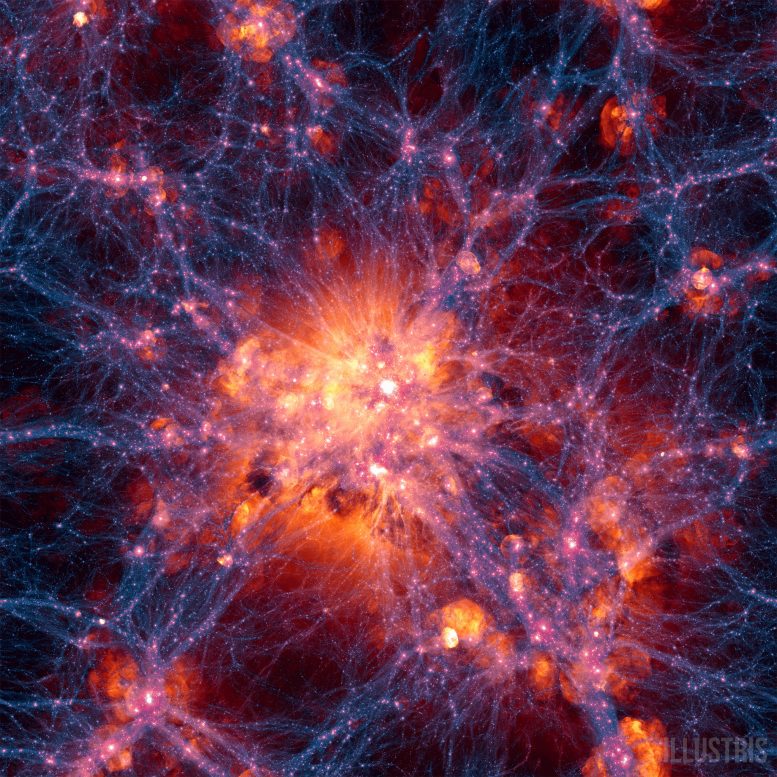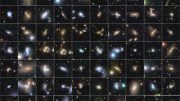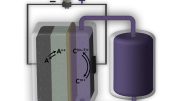
A snapshot from the Illustris Project computer simulation of cosmic structure formation. This artificially colored image shows filaments and galaxies in the web of cosmic matter, as seen today over a field-of-view about fifty million light-years across. Credit: The Illustris Project
New research from the Illustris project examines the changing frequency of galaxy collisions, as the universe evolves from the Big Bang to the present day.
Our knowledge of the Big Bang has increased dramatically in the past decade, as satellites and ground-based studies of the cosmic microwave background have refined parameters associated with the very early universe, achieving amazing precisions (though not necessarily accuracies) of a few percent. Unfortunately, our knowledge of what happened after that – from those first few hundred thousand years until today, 13.7 billion years later – is very much a work-in-progress. We know that galaxies and their stars formed out of the cooling, filamentary network of matter from that early era. They re-ionized the hydrogen gas, and then continued to evolve, and collide with one another as the universe steadily expanded. Distant galaxies are faint and hard to detect, however, and although observations have made excellent progress in piecing together the story line, astronomers have turned to theory and computer simulations to try to complete the picture.
There are three main theoretical approaches to study the cosmic frequency of galaxy mergers, which differ in how they model galaxies. The first approach does not attempt to model galaxy formation from first principles, and instead “paints” galaxies onto the dark matter environment (they are called “halos”) according to constraints set by observations. The second approach models galaxy formation by means of simple mathematical recipes, again using dark matter halos as the backbone of the model. The third method, hydrodynamic simulations, attempts to model everything (dark matter, gas, and stars) self-consistently, a task that until recently had been computationally too difficult.
The Illustris simulation is the most ambitious computer simulation of our Universe yet performed. The calculation tracks the expansion of the universe, the gravitational pull of matter onto itself, the motion of cosmic gas, as well as the formation of stars and black holes. These physical components and processes are all modeled starting from initial conditions resembling the very young universe 300,000 years after the Big Bang and until the present day, spanning over 13.8 billion years of cosmic evolution. The simulated volume contains tens of thousands of galaxies captured in high-detail, covering a wide range of masses, rates of star formation, shapes, sizes, and with properties that agree well with the galaxy population observed in the real universe. The simulations were run on supercomputers in France, Germany, and the US. The largest was run on 8,192 compute cores, and took 19 million CPU hours. A single state-of-the-art desktop computer would require more than 2000 years to perform this calculation. Find out more at: http://www.illustris-project.org
CfA astronomers Vicente Rodriguez-Gomez, Shy Genel, Annalisa Pillepich, Dylan Nelson, and Lars Hernquist and their colleagues have developed a new theoretical framework for calculating the frequency of galaxy mergers in the Illustris Project, a cosmological hydrodynamic simulation which models the formation of galaxies in cosmic volumes about three hundred million light-years in size, huge enough to replicate many known properties of galaxies and clusters both locally and at earlier epochs. The large volume, the self-consistent treatment of normal matter, and the realistic galaxy formation model used, allows the Illustris simulation to provide an unprecedented and precise study of mergers over cosmic time.
The astronomers find clear evidence for steadily decreasing galaxy merger rates (the merger frequency three billion years after the Big Bang was about fifteen times higher than it is today), and they clarify the nature of mergers, for example, finding the most useful definition for the mass ratio of the merging galaxies and constraining the epoch of mass infall during a collision. They report some sharp differences between their results and those predicted by some other popular theories, as well as some ambiguities in the (still imprecise) observed datasets. Their important research marks the start of a more detailed series of investigations into the cosmic evolution of galaxies.
Reference: Vicente Rodriguez-Gomez, et al., “The Merger Rate of Galaxies in the Illustris Simulation: A Comparison with Observations and Semi-empirical Models” by Vicente Rodriguez-Gomez, Shy Genel, Mark Vogelsberger, Debora Sijacki, Annalisa Pillepich, Laura V. Sales, Paul Torrey, Greg Snyder, Dylan Nelson, Volker Springel, Chung-Pei Ma and Lars Hernquist, 14 March 2015, MNRAS.
DOI: 10.1093/mnras/stv264
arXiv: 1502.01339









Be the first to comment on "The Changing Frequency of Galaxy Collisions"